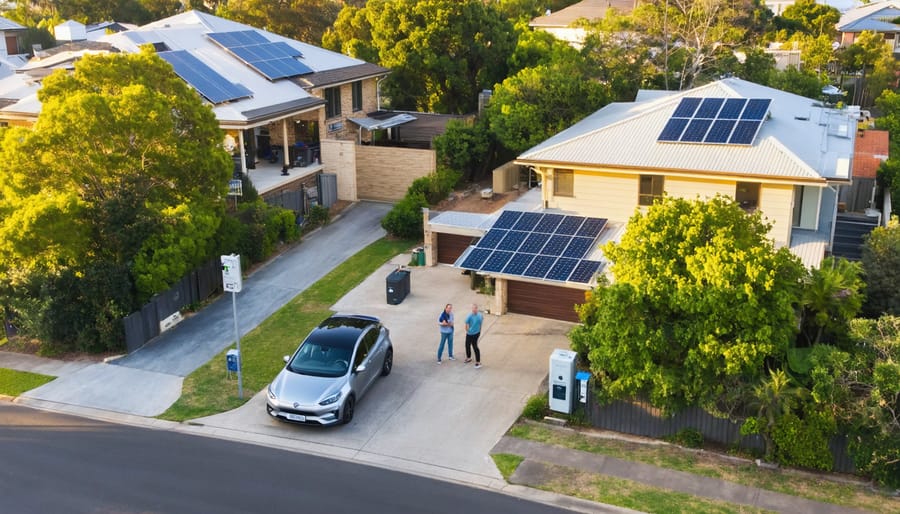Imagine your street powered entirely by shared solar panels on neighbourhood rooftops, your community hall heated by locally sourced bioenergy, and your neighbours collaborating to slash everyone’s electricity bills while cutting carbon emissions by half. This isn’t a far-off fantasy. Green communities are transforming Australian suburbs right now, proving that collective action delivers environmental and economic wins that individual households simply cannot achieve alone.
Green communities unite residents, local councils, and businesses around shared renewable energy infrastructure and sustainable practices. They’re sprouting across Australia, from coastal towns installing community battery systems to urban precincts retrofitting entire apartment blocks with energy-efficient technology. These initiatives pool resources, knowledge, and purchasing power to make clean energy accessible and affordable for everyone, not just those who can afford rooftop solar or home batteries.
The momentum is undeniable. Community energy projects have grown by 300 percent in recent years, driven by Australians frustrated with rising power costs and determined to take climate action into their own hands. What makes these communities succeed isn’t complicated technology or massive budgets. It’s neighbours talking over the fence, local champions stepping up to coordinate projects, and councils providing the regulatory support to make shared infrastructure possible.
Whether you’re a resident wanting lower energy bills, a community leader seeking tangible sustainability outcomes, or a professional exploring collaborative renewable models, green communities offer a proven pathway. They demonstrate that environmental responsibility and economic sense aren’t competing priorities. They’re two sides of the same coin, achievable when communities work together with clear strategies, realistic timelines, and commitment to collective benefit over individual gain.
What Makes a Community ‘Green’?
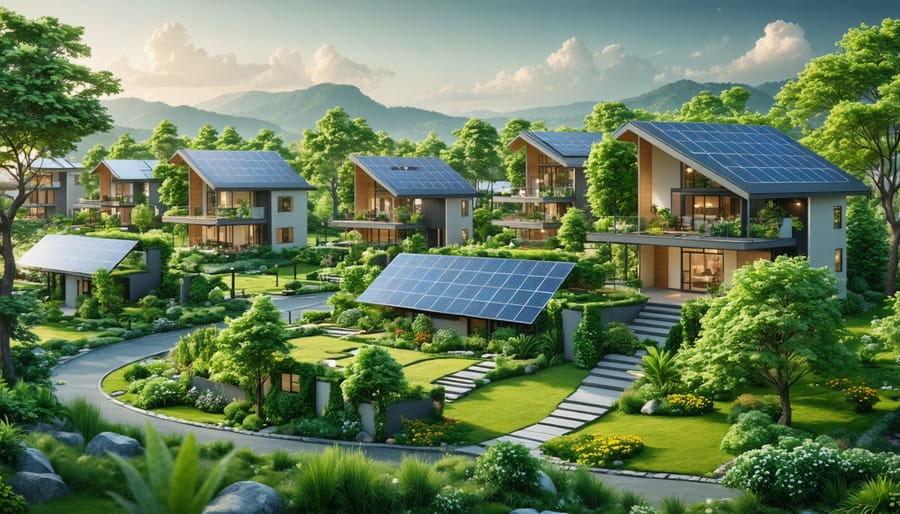
Beyond Solar Panels: The Power of Collective Action
While installing solar panels on individual homes makes a difference, the real magic happens when entire communities band together. Green communities demonstrate that collective action multiplies impact far beyond what any single household can achieve.
Take shared infrastructure as an example. When neighbourhoods pool resources, they can install larger renewable energy systems, community battery storage, and district heating networks that would be financially out of reach for individual families. The Byron Bay community renewable energy hub shows how shared solar arrays can power multiple homes at a fraction of the cost per household.
Bulk purchasing power transforms the economics too. Communities negotiating together secure better prices on equipment, installation, and maintenance. Some Australian green communities have achieved 30-40% savings compared to individual purchases, making sustainable living more accessible to average families.
Maintenance becomes simpler and cheaper when shared. Instead of each household hiring separate technicians, communities employ shared expertise or negotiate service contracts that cover everyone. This approach reduces costs and ensures systems run efficiently.
Perhaps most importantly, coordinated efforts create momentum. When neighbours see their community achieving energy independence together, it inspires participation. Skills are shared, knowledge spreads naturally, and the transition to renewable energy becomes a neighbourhood journey rather than a lonely experiment. This collective approach turns sustainability from an individual burden into a shared achievement that strengthens community bonds while protecting our environment.
The Bioenergy Advantage in Community Settings
Bioenergy offers green communities a distinct advantage through its ability to transform local waste into reliable power. Unlike solar and wind, which depend on weather conditions, bioenergy systems provide consistent baseload power while simultaneously addressing waste management challenges. For Australian communities, this means turning agricultural residues, municipal organic waste, and forestry by-products into valuable energy resources rather than letting them become disposal problems.
The scalability of bioenergy makes it particularly suited to community applications. A small town in regional Victoria might operate a modest anaerobic digester processing food waste from local businesses and households, while a larger municipality could develop a comprehensive biomass facility utilizing nearby agricultural operations. This flexibility allows communities to start small and expand as resources and demand grow.
Australian green communities are already demonstrating bioenergy’s practical benefits. The Yarra Valley in Victoria has successfully integrated bioenergy systems that process organic waste from local wineries and farms, generating electricity for hundreds of homes while reducing landfill dependency. Similarly, communities in regional Queensland are exploring sugarcane bagasse conversion, turning what was once considered waste into a reliable power source.
The real beauty of community-scale bioenergy lies in its circular economy approach. Local organic materials stay local, creating jobs in collection, processing, and maintenance while keeping energy dollars within the community. This closed-loop system strengthens local resilience, reduces transportation emissions, and builds energy independence. For communities serious about sustainability, bioenergy provides both immediate practical benefits and long-term environmental advantages that complement other renewable energy sources perfectly.
Real Green Communities Making Waves Across Australia
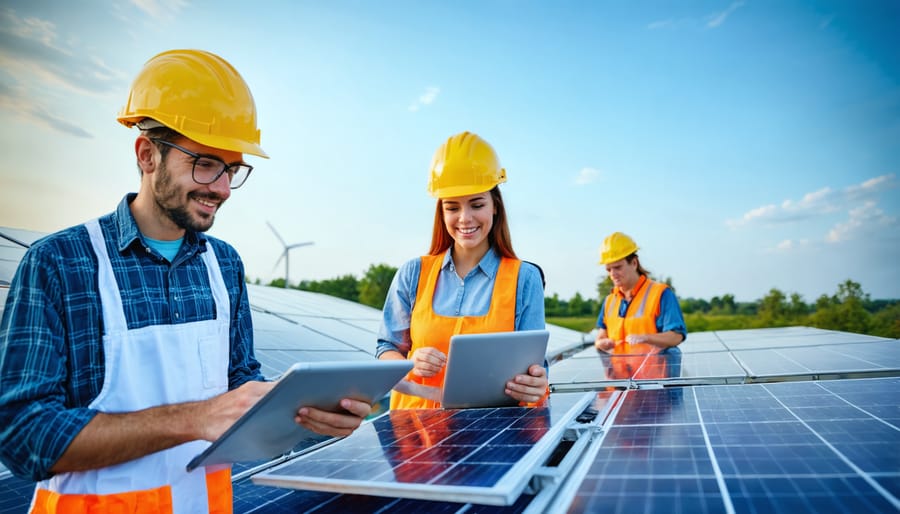
Christie Walk, Adelaide: Urban Density Done Right
Tucked away in Adelaide’s inner suburbs, Christie Walk stands as Australia’s first urban eco-village, proving that sustainable living doesn’t require sacrificing city convenience. Since 2006, this compact development has housed around 27 dwellings on less than two hectares, demonstrating how thoughtful design creates thriving green communities.
The secret lies in its integrated approach. Every home features passive solar design, with north-facing windows capturing winter warmth while deep eaves block harsh summer sun. Shared solar panels generate collective energy, cutting electricity bills by up to 60 percent compared to conventional homes. Rainwater tanks and greywater systems reduce mains water use by approximately 70 percent, creating genuine environmental impact.
What truly sets Christie Walk apart is its governance model. Residents actively participate in decision-making through regular meetings, fostering genuine community connection. Shared gardens provide fresh produce while encouraging neighbourly interaction, and car-free central pathways prioritise people over vehicles.
The results speak volumes. Resident surveys consistently show satisfaction rates above 90 percent, with many citing the strong community bonds as their favourite aspect. Energy monitoring reveals the development uses roughly 40 percent less energy than similar-sized conventional homes.
Christie Walk proves that urban density and sustainability can coexist beautifully, offering a replicable blueprint for Australian cities seeking genuine environmental solutions while building connected communities.
Randwick Community Garden’s Energy Revolution
In Sydney’s eastern suburbs, the Randwick Community Garden has become a brilliant example of how food production and renewable energy can work hand in glove. When the community garden committee faced mounting electricity costs for their irrigation systems and tool shed, they saw an opportunity rather than a problem.
The solution? A 5-kilowatt solar array installed above raised garden beds, creating a dual-purpose system that generates clean energy while providing partial shade for heat-sensitive crops during scorching summer months. This clever design increased crop yields by 30% while slashing energy bills to near zero.
The garden now powers its entire operation, including electric composting systems and a small cool room for storing harvested produce. Excess energy feeds back into the local grid, earning credits that support community programs teaching kids about sustainable food production.
What makes this project special is its accessibility. Working with local council support and volunteer labour, the total investment came to just $8,000. Within three years, energy savings and improved productivity had paid for the installation.
Today, the site hosts regular workshops where other community groups learn to replicate this food-energy model, proving that even small urban spaces can make a big difference.
Regional Success: How a Queensland Town Turned Waste into Watts
In rural Queensland, the agricultural town of Dalby has transformed its farming waste into a powerful renewable energy solution. Facing mountains of crop residue and agricultural biomass after each harvest, the community partnered with local energy innovators to establish a biomass energy facility that now powers hundreds of homes and businesses.
The facility converts cotton gin trash, macadamia shells, and wheat stubble into clean electricity and heat through a process called gasification. What was once burned in paddocks, releasing emissions into the atmosphere, now generates 6 megawatts of renewable power while creating 45 permanent jobs in the region.
Local farmer Tom Henderson explains the transformation: “We’re no longer just growing crops, we’re growing energy. The extra income from selling our agricultural waste has been a game-changer during tough seasons.”
The project has reduced the town’s carbon emissions by 18,000 tonnes annually while keeping energy dollars circulating within the local economy. The biomass facility also provides district heating to the regional hospital and nearby processing facilities, demonstrating how agricultural communities can lead Australia’s renewable energy transition. This practical approach proves that regional towns possess untapped potential to become energy self-sufficient while strengthening their economic resilience.
Practical Energy Solutions Your Community Can Implement
Shared Solar and Battery Storage Systems
Community solar gardens are transforming how Australians access renewable energy, particularly for renters and apartment dwellers who can’t install rooftop panels. These shared facilities allow multiple households to subscribe to a portion of a larger solar array, receiving credits on their electricity bills proportional to their investment. In Melbourne’s Darebin suburb, a 100kW community solar project has delivered returns of 8-12% annually while reducing participants’ energy bills by up to 25%.
Virtual power plants take this collaboration further by linking shared battery installations across multiple properties. South Australia’s pioneering virtual power plant network connects over 4,000 homes, creating a distributed energy resource that stabilizes the grid while providing members with backup power during outages.
Cost-sharing models make these systems accessible through various approaches. Some communities use cooperative ownership structures where members buy shares starting from $500, while others operate subscription models with monthly fees covering installation and maintenance. Byron Bay’s renewable energy cooperative demonstrates the potential beautifully, with 300 households collectively saving $180,000 annually while achieving 85% renewable energy independence. These collaborative approaches prove that going green doesn’t mean going alone.
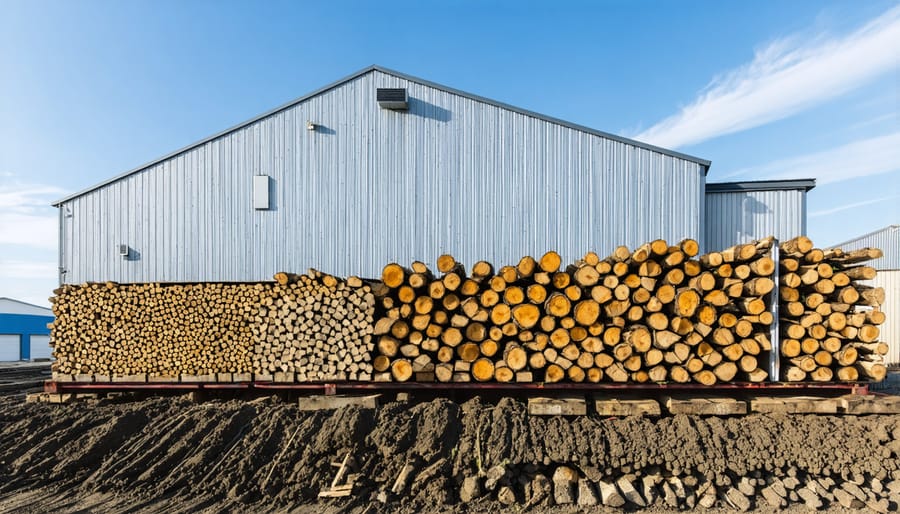
District Bioenergy Systems: From Concept to Reality
Imagine turning your community’s organic waste into clean, reliable energy that heats and cools neighbourhood buildings. That’s the beauty of district bioenergy systems, and Australian communities are already making it happen.
These systems work by collecting local biomass—think agricultural waste, timber offcuts, or green waste from parks—and converting it into thermal energy through efficient combustion or gasification. The heat travels through insulated underground pipes to warm homes, schools, and businesses during winter, while absorption chillers can provide cooling in summer.
The key to success starts with sustainable sourcing. Your community needs a reliable supply of biomass within reasonable transport distance. Partner with local farmers, timber mills, or council green waste programs to secure feedstock that would otherwise decompose or be burned inefficiently.
System design needn’t be daunting. Start small with a central boiler station and expand your pipe network gradually. Modern systems include automated fuel handling, emission controls, and smart monitoring that adjust output based on demand.
Maintenance involves regular ash removal, annual boiler servicing, and monitoring fuel quality—straightforward tasks that create local jobs. Several Victorian and South Australian towns already demonstrate how district heating transforms waste into warmth, proving this technology works brilliantly in Australian conditions.
Energy-Efficient Community Buildings and Shared Spaces
Community buildings and shared spaces represent brilliant opportunities to showcase green building principles at scale. Across Australia, forward-thinking developments are embracing passive design strategies that work with our climate rather than against it. By orienting buildings to capture winter sun while providing summer shade, these spaces naturally regulate temperature, slashing energy bills and carbon emissions.
Natural ventilation through strategically placed windows and vents keeps air flowing without mechanical systems, whilst sustainable materials like recycled timber and low-VOC paints create healthier indoor environments. The success story of Brisbane’s Cascade Gardens community centre demonstrates this beautifully—their solar panels, rainwater harvesting, and natural cooling systems have reduced operating costs by 60 percent while creating a welcoming hub for residents.
Multi-dwelling developments are following suit, with shared amenities like rooftop gardens, community kitchens, and energy storage systems proving that collective action yields remarkable results. These spaces don’t just reduce environmental impact; they foster connection and demonstrate that sustainable living can be both practical and inspiring for communities ready to embrace change.
Getting Your Community Started: A Practical Roadmap
Building the Right Team and Getting Buy-In
Creating a thriving green community starts with people, not panels. Begin by having genuine conversations with your neighbours over a cuppa, sharing your vision and listening to their concerns and ideas. You’ll quickly discover unexpected champions—perhaps the retired engineer down the street or the school teacher passionate about environmental education.
Establish a steering committee with diverse representation from different age groups, cultural backgrounds, and skill sets. This ensures decisions reflect everyone’s needs, not just the keenest green advocates. The Byron Bay community energy project succeeded partly because they included sceptics early on, transforming doubters into powerful advocates.
Keep momentum alive through regular community barbecues, workshops, and site visits to existing green projects. Melbourne’s Moreland Energy Foundation demonstrates how practical demonstrations—like showing actual energy bills before and after solar installation—convert curiosity into commitment. Make participation easy with flexible meeting times and online options for those who can’t attend in person.
Remember, building consensus takes patience. Celebrate small wins along the way, acknowledge contributions publicly, and maintain transparent communication about challenges and progress. When people feel genuinely heard and valued, they’ll stick with the journey through inevitable bumps in the road.
Funding and Support Available in Australia
Australian communities pursuing green building and energy initiatives have access to substantial funding opportunities. The federal government’s Community Batteries for Household Solar Program provides grants for shared energy storage, perfect for neighbourhood-scale projects. State governments offer targeted support too – Victoria’s Sustainability Victoria grants, NSW’s Net Zero Emissions program, and Queensland’s Climate Action Grants all fund community renewable projects.
The Clean Energy Finance Corporation provides green loans with favourable terms for community projects, while their investment often attracts additional private funding. Community housing providers can access National Housing Finance and Investment Corporation funding for energy-efficient retrofits.
Many communities successfully use community financing models like crowd-funding platforms or community bonds. The Mallacoota Community Recovery Hub secured funding through multiple streams, combining government grants with community investment.
For successful applications, clearly demonstrate community support through surveys and letters of endorsement. Include realistic costings, measurable environmental outcomes, and long-term sustainability plans. Partner with local councils or established organisations to strengthen applications. Remember, many programs prioritise projects in regional areas or disadvantaged communities, so highlight relevant local benefits. Start conversations early with funding bodies – they often provide pre-application advice that significantly improves your chances.
Navigating Permits, Regulations, and Energy Providers
Getting your green community project off the ground doesn’t need to be overwhelming. Start by reaching out to your local council early in the planning process—they’re often more supportive than you’d expect and can guide you through development approval requirements specific to your area. Many councils have sustainability officers dedicated to helping communities like yours navigate the paperwork.
For solar installations and energy storage systems, you’ll need electrical permits and grid connection agreements with your energy retailer. The good news? Most energy providers now have streamlined processes for community renewable projects, having learned from successful projects across Australia. Request a pre-application meeting to understand connection costs and timelines upfront.
Compliance with Australian Standards is essential, but certified installers handle most technical requirements. Your job is ensuring contracts clearly outline responsibilities and deadlines. Consider engaging a community energy consultant who knows the regulatory landscape—they’ll save you time and headaches.
Top tip: Document everything and maintain open communication with all stakeholders. Approvals typically take three to six months, so factor this into your timeline and keep your community informed along the way.
The Ripple Effects: Benefits Beyond Energy Savings
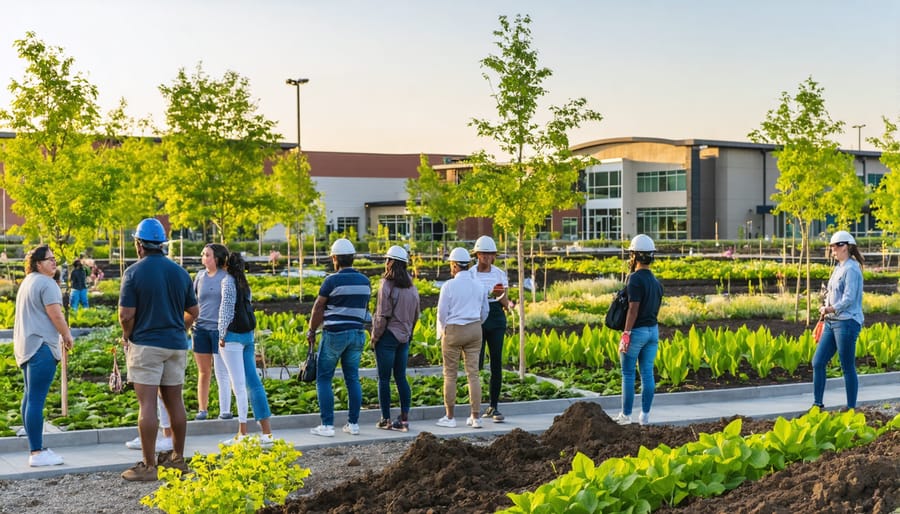
Creating Local Jobs and Skills
Green communities are creating real opportunities for Australians right across the country. Installing solar panels, maintaining community battery systems, and managing bioenergy facilities require skilled workers, and these jobs stay local. From Byron Bay to regional Queensland, communities implementing renewable projects are training residents in everything from electrical work to project management.
The renewable sector is experiencing remarkable growth, with training programs popping up at TAFEs and community colleges nationwide. These aren’t just short-term gigs either – they’re genuine career pathways. A solar installer in rural Victoria might progress to project coordination, while someone maintaining a community microgrid could develop expertise in smart energy systems.
Bioenergy production facilities, which convert organic waste into power, create diverse employment opportunities spanning collection, processing, and technical maintenance. These roles suit people with various skill levels, making the transition to clean energy accessible to more Australians. Local councils are partnering with renewable companies to offer apprenticeships and upskilling programs, ensuring communities benefit directly from the shift to sustainable energy solutions.
Strengthening Social Bonds and Community Pride
Beyond the environmental wins, green community projects create something equally valuable: stronger connections between neighbours. When residents come together to install solar panels on a community hall or establish a shared composting system, they’re not just reducing emissions—they’re building relationships that last well beyond the project’s completion.
Take the Northern Rivers community in New South Wales, where locals collaborated on a renewable energy cooperative. What started as practical discussions about power bills evolved into barbecues, skill-sharing workshops, and genuine friendships. Residents discovered hidden talents among their neighbours—electricians, project managers, and passionate advocates who might have remained strangers otherwise.
This shared purpose transforms abstract environmental goals into tangible collective achievements. Community members feel genuine pride when they see solar arrays they helped fund powering local facilities, or when energy bills drop thanks to their collective efforts. It’s the difference between reading about sustainability and actually creating it together.
The ripple effects extend beyond the immediate project too. Communities that successfully collaborate on green initiatives often find themselves better equipped to tackle other challenges, from emergency preparedness to youth programs. They’ve built trust, established communication networks, and proven they can achieve remarkable things when working as one. That social capital becomes the foundation for an even more resilient, connected community.
Overcoming Common Challenges
Let’s be honest—launching a green community initiative isn’t always smooth sailing. Many Australian communities have faced similar hurdles, and understanding these challenges upfront can help you navigate them successfully.
Initial skepticism often tops the list of obstacles. Neighbours might question whether renewable energy really works or if it’s worth the effort. The solution? Start with education sessions and site visits to existing projects. When residents from Canberra visited a nearby solar community, seeing actual energy bills drop by 60% transformed doubters into advocates within weeks.
Financial concerns naturally arise, especially regarding upfront costs. However, creative solutions exist. Many communities have successfully secured government grants, partnered with green banks offering favorable loan terms, or implemented staged rollouts. The shared cost model, where expenses are divided among participants, makes projects surprisingly affordable. Some groups even establish community energy cooperatives, allowing residents to invest according to their means.
Technical complications can feel overwhelming, particularly for communities without engineering expertise. The good news? You don’t need to become experts yourselves. Partnering with experienced consultants, local universities, or established renewable energy providers brings necessary knowledge to your project. Melbourne’s Brunswick community tapped into pro-bono support from environmental engineering students, creating a win-win situation.
Coordination difficulties emerge when managing diverse opinions and schedules. Appointing a small steering committee with clear roles helps maintain momentum. Regular communication through newsletters, community meetings, and digital platforms keeps everyone informed and engaged. Setting realistic timelines prevents burnout—remember, Rome wasn’t built in a day, and neither is a sustainable community.
Drawing from real experiences from Australian communities, the key message is this: challenges are normal, but they’re absolutely surmountable. Every successful green community faced obstacles initially. What set them apart wasn’t avoiding problems—it was persistence, creativity, and willingness to learn together. Your community has these qualities too.
The transformation of Australia’s communities into thriving, sustainable hubs isn’t just a dream—it’s already happening, and you can be part of this remarkable journey. From suburban streets in Adelaide to coastal towns in Queensland, ordinary Australians are proving that green communities represent one of our most powerful tools for tackling climate change while creating places where people genuinely want to live.
The beauty of this movement is that it doesn’t require waiting for sweeping policy changes or massive infrastructure overhauls. It starts with a simple conversation at your next community meeting, a chat over the fence with your neighbour, or an email to your local council. Every successful green community began exactly where yours is now—with people who decided that the future was worth building together.
Think about what’s possible when your community harnesses renewable energy, reduces waste, and creates green spaces that bring people together. Lower energy bills, cleaner air, stronger neighbourhood connections, and the satisfaction of knowing you’re leaving something better for the next generation. These aren’t small wins—they’re the building blocks of a genuinely sustainable Australia.
The pathway forward is clear, the success stories are real, and the benefits are proven. So gather your neighbours, share your vision, and take that first step. Australia’s sustainable energy future won’t be built by governments or corporations alone—it’ll be built by communities like yours, one committed neighbourhood at a time. The question isn’t whether green communities work; it’s when your community will join this exciting transformation.

